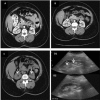Nonobstructive hydronephrosis due to social polydipsia: a case report
- PMID: 23130747
- PMCID: PMC3514125
- DOI: 10.1186/1752-1947-6-376
Nonobstructive hydronephrosis due to social polydipsia: a case report
Abstract
Introduction: Excessive fluid intake can lead to water intoxication, electrolyte abnormalities, exacerbation of heart failure and anatomical changes in the urinary tract that may present diagnostic and therapeutic challenges for patients and physicians. Although the development of nonobstructive hydronephrosis is recognized in patients with central and nephrogenic diabetes insipidus, pregnancy or psychiatric polydipsia, it is rarely a diagnostic consideration in healthy individuals with excessive fluid ingestion. We now present what we believe to be the first report of nonobstructive hydronephrosis associated with social polydipsia.
Case presentation: A 53-year-old African-American woman with moderate back pain was found to have bilateral moderate hydronephrosis and hydroureter by abdominal computed tomography. She underwent ureteral stent placement followed by exploratory laparoscopy with lysis of adhesions and a right oophorectomy, without resolution of the nonobstructive hydronephrosis. A careful assessment revealed a social habit of consuming approximately 5.5L of fluid daily in an effort to remain hydrated in accordance with public health service announcements. It was recommended that the patient reduce her fluid intake. A repeat ultrasound after six weeks revealed complete resolution of the bilateral hydronephrosis and hydroureter.
Conclusion: Recognition of the nonobstructive nature of hydronephrosis caused by polydipsia in healthy individuals is important to prevent unnecessary interventions.
Figures

References
-
- Food and Nutrition Board, National Academy of Sciences. Recommended dietary allowances. Natl Res Coun, Repr and Circ Ser. 1945;122:3–18.
-
- Institute of Medicine (U.S.) Food and Nutrition Board. Panel on Dietary Reference Intakes for Electrolytes and Water, Standing Committee on the Scientific Evaluation of Dietary Reference Intakes: Dietary reference intakes: water, potassium, sodium, chloride and sulfate. Washington DC: National Academies Press; 2004.
-
- Illowsky BP, Kirch DG. Polydipsia and hyponatremia in psychotic patients. Am J Psychiatry. 1988;145:675–683. - PubMed
LinkOut - more resources
Full Text Sources

